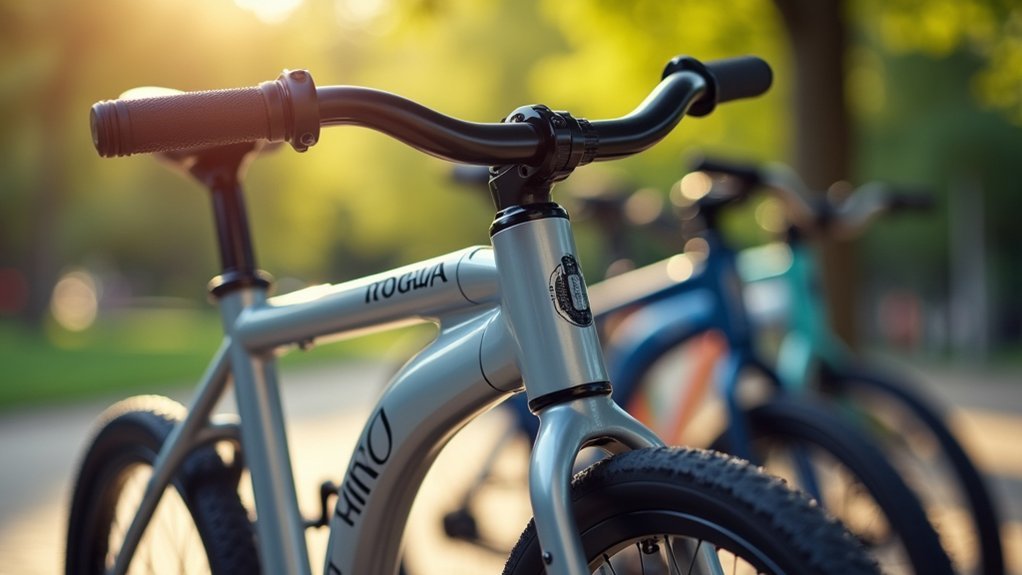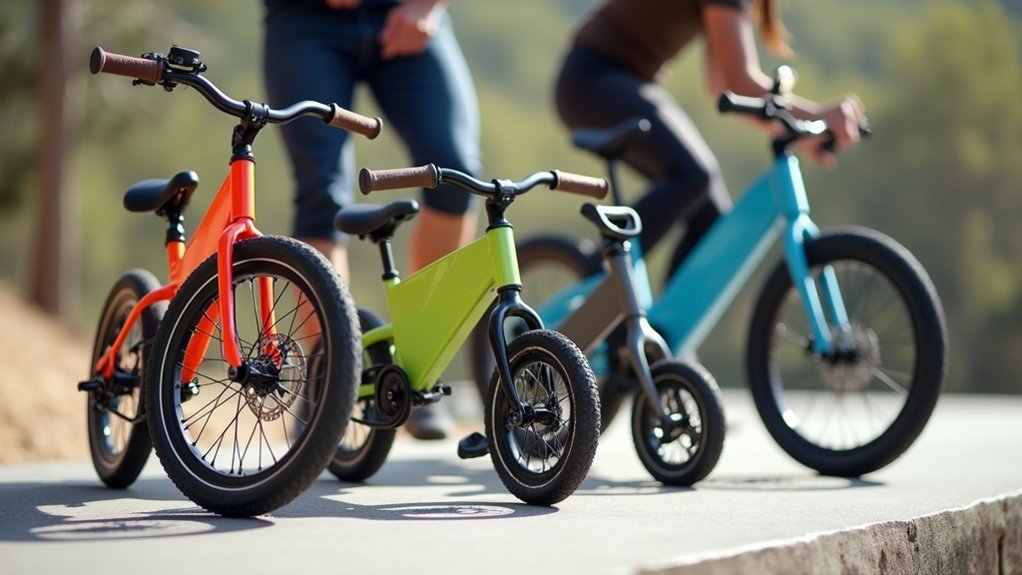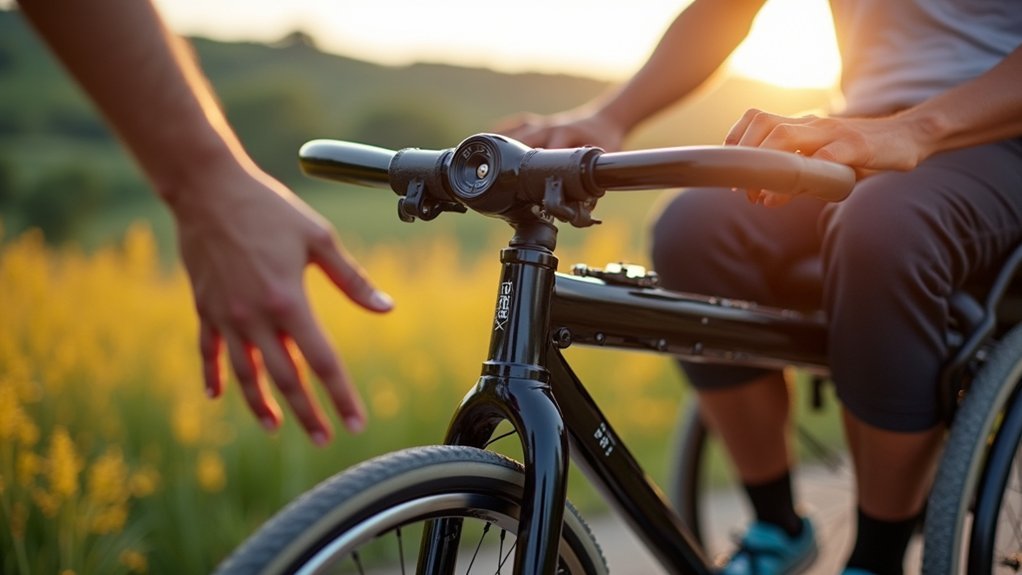When choosing a hand cycle for your wheelchair, consider your mobility needs, fitness goals, and intended terrain. Test different types—attachable, recreational, racing, or off-road models—to find what feels right. Guarantee proper fit by measuring your seated position, arm reach, and trunk stability. Evaluate components like frame material, braking systems, and gears for quality and usability. Don’t overlook power assist options if you want extended range with less fatigue. The perfect hand cycle balances comfort, function, and your personal requirements.
How to Choose Hand Cycles for Wheelchairs

When selecting a hand cycle for your wheelchair, compatibility should be your first consideration. Check whether models like the Quickie Attitude range will attach properly to your wheelchair frame to guarantee ideal functionality.
Next, determine your intended use. Are you looking for a casual hand bike for neighborhood rides, urban commuting, or competitive handcycles for sports? Your purpose will dictate the design features you’ll need.
Don’t overlook personalization options—adjustable seating positions and handlebar configurations greatly impact your comfort and performance.
Always test ride multiple models before deciding, as the feel of each cycle varies considerably.
Finally, look for ergonomic grips and support wheels that make shifting between wheelchair and cycling modes effortless. These features will enhance your overall experience and independence.
Assessing Your Mobility Needs and Fitness Goals
Before selecting a hand cycle, you’ll need to honestly evaluate your current mobility capabilities to determine whether an arm-powered, leg-powered, or combination model will serve you best.
Establish clear fitness objectives, whether you’re aiming for recreational enjoyment, competitive performance, or enhanced daily independence, as these goals will directly influence your equipment needs.
Consider working with a physical therapist or adaptive sports specialist who can help you set realistic fitness targets based on your specific physical condition and potential for improvement.
Evaluating Mobility Limitations
Understanding your specific mobility needs forms the foundation of selecting an appropriate hand cycle for your wheelchair. Start by honestly evaluating which limbs you can effectively use for propulsion.
If you have upper body strength and control, you’ll likely benefit from different types of hand cycles than someone with limited arm mobility. Consider whether you can use both arms equally or if you have strength imbalances that might affect your cycling technique.
Some hand cycles are designed for users with varied mobility limitations, offering adaptable features to accommodate different ability levels.
Don’t forget to evaluate your trunk stability, as this impacts the type of seating and support you’ll need. The right hand cycle should complement your existing abilities while helping you achieve greater independence and mobility.
Setting Realistic Fitness Targets
After addressing your mobility limitations, the next step involves setting realistic fitness targets that align with your capabilities.
When choosing hand bikes, consider what you’re aiming to achieve—whether it’s building endurance, increasing upper body strength, or simply enjoying recreational rides.
Evaluate the terrain you’ll primarily travel on, as this directly impacts which hand cycle will serve you best. Smooth pavements require different equipment than challenging trails.
Remember that your fitness goals should be achievable yet progressive, allowing room for improvement as your training advances.
Don’t hesitate to consult with adaptive sports specialists who can help match your fitness targets with appropriate equipment.
With consistent practice, you’ll notice improvements in speed and stamina, so select a hand cycle that accommodates adjustments as your abilities grow.
Types of Hand Cycles and Their Specific Applications

Various hand cycles exist to meet the diverse needs of wheelchair users, each designed with specific features for different activities and environments.
Hand cycles offer specialized mobility solutions for wheelchair users, with each design tailored to specific activities and terrains.
When exploring the variety of handcycles, you’ll find options spanning recreational and competitive purposes.
- Attachable hand cycles convert your existing wheelchair into a versatile mobility device, offering flexibility without requiring a complete equipment change.
- Recreational models feature upright seating positions and user-friendly controls, perfect for beginners or casual rides around the neighborhood.
- Racing hand cycles utilize aerodynamic designs and lightweight materials for competitive cyclists seeking speed and performance.
- Off-road versions come equipped with robust suspension systems and wide tires to tackle rugged terrain, while pediatric options cater specifically to children’s needs and proportions.
Proper Fit and Ergonomics for Maximum Comfort
Finding your ideal handcycle fit starts with correctly measuring your seated position to guarantee proper alignment with the frame.
You’ll need to verify that components like the seat height, backrest, and footrests are fully adjustable to accommodate your specific body dimensions and mobility needs.
Complete an arm-reach assessment while in riding position to confirm the handlebars are positioned at a comfortable distance that allows natural arm extension without straining your shoulders or back.
Measuring Seated Position
The foundation of a comfortable hand cycling experience begins with proper measurements of your seated position.
When selecting a hand cycle, you’ll need precise measurements to guarantee top-notch ergonomics and prevent strain during rides.
To properly measure your seated position:
- Determine the distance from your seat to the floor while in your wheelchair, which establishes the ideal frame size and pedaling height.
- Measure from your back to where your hands comfortably reach to set the proper range of hand movement when gripping handlebars.
- Check knee clearance by measuring the space between your seat and the pedal mechanism in the seated position.
- Compare your hip width to potential seat options, providing adequate support without creating pressure points.
These measurements will help you find a hand cycle that aligns perfectly with your body mechanics.
Adjustable Components Check
Five critical adjustment points determine whether your hand cycle will deliver long-term comfort or persistent discomfort.
First, verify the handlebars can be adjusted in height to match your arm length and provide a comfortable grip that prevents upper body fatigue during rides.
Next, examine the adjustable seating system—both height and tilt should be customizable to support your back and hips properly.
The pedal positioning must also be adaptable to find your ideal angle, reducing strain while maximizing cycling efficiency.
Ensure the frame length can be modified to accommodate your body size, as proper fit dramatically improves stability and control.
Finally, look for ergonomic grips and cushioning that can be tailored to your specific needs, particularly important for maintaining comfort during longer rides and preventing unnecessary fatigue in your upper body.
Arm-Reach Assessment
Proper arm-reach measurement forms the foundation of hand cycle comfort and efficiency. Different styles of handcycles offer varying geometries, so you’ll need to assess your specific requirements before making a decision.
When evaluating your arm reach compatibility:
- Extend your arms toward the handcycle’s controls while seated in your wheelchair – you should reach all components without straining or fully extending your elbows.
- Check that your elbows maintain a slight bend (approximately 15-30 degrees) when gripping the handles.
- Test adjustable handlebars at various heights to find your ideal position that prevents shoulder fatigue.
- Verify the distance between your torso and the crank system allows for full rotation without your knees or chair interfering.
Always test ride before purchasing to confirm that your arm reach suits the handcycle’s geometry during actual use.
Evaluating Hand Cycle Components and Quality
Selecting quality components for your hand cycle guarantees both safety and performance over time.
Begin by examining the frame material—aluminum offers excellent lightweight strength for everyday use, while carbon fiber provides superior performance with reduced weight for competitive cycling.
Next, inspect the braking system for reliable stopping power. Confirm the brakes are easily accessible and consider models with single-handed operation for convenience and safety.
Don’t overlook the gear system, which should shift smoothly and offer range appropriate for your terrain. Racing models typically feature manual shifters, while recreational cyclists might prefer automatic systems.
Finally, assess the tires and wheels for your intended use—wider for off-road stability or thinner for speed—and look for adjustable components that accommodate your specific comfort needs.
Power Assist Options for Extended Range and Accessibility

How can power assist technology transform your hand cycling experience?
Power assist systems make it possible for you to tackle rough terrain and longer journeys with less fatigue. These electric motor additions offer adjustable support levels, customized to your strength and riding conditions.
- Electric motors can be retrofitted to many modern hand cycles, enabling riders with limited upper body strength to maintain higher speeds.
- Multiple assistance levels let you tailor the power boost based on your physical capabilities and the challenges of your route.
- Regenerative braking technology recharges batteries during downhill sections, maximizing your cycling range.
- Power assist technology promotes independence, allowing you to join cycling activities you might otherwise find too demanding.
This technology creates new possibilities for exploring diverse environments without excessive exertion.
Frequently Asked Questions
Why Are Handcycles so Expensive?
Handcycles are expensive because they’re crafted with premium materials like carbon fiber, feature specialized technology, require extensive R&D, offer customization options for your specific needs, and are produced by high-end adaptive sports manufacturers.
What Is the Difference Between Handcycle and Wheelchair Racing?
In handcycle racing, you’ll propel yourself in a reclined position using arm-powered cranks, while in wheelchair racing, you’ll push forward in an upright position using specialized push rims on your wheels.
How Fast Can a Handcycle Go?
Handcycles can reach impressive speeds. You’ll typically cruise at 12-15 mph on flat terrain with good fitness. Competitive racers can exceed 30 mph, while motorized versions are often limited to 15 mph for safety.
How Do You Steer a Handcycle?
You steer a handcycle by turning the handlebars connected to the front wheel. You’ll use your arms and upper body to control direction, leaning slightly into turns while maintaining balance for smoother navigation.
In Summary
By choosing the right hand cycle for your wheelchair, you’ll gain independence and improve your fitness level. Take time to assess your needs, try different models, and guarantee proper fit before investing. Remember, it’s worth consulting with mobility specialists and experienced users. With the right hand cycle attachment, you’ll expand your horizons and enjoy a new level of freedom and physical activity.





Leave a Reply